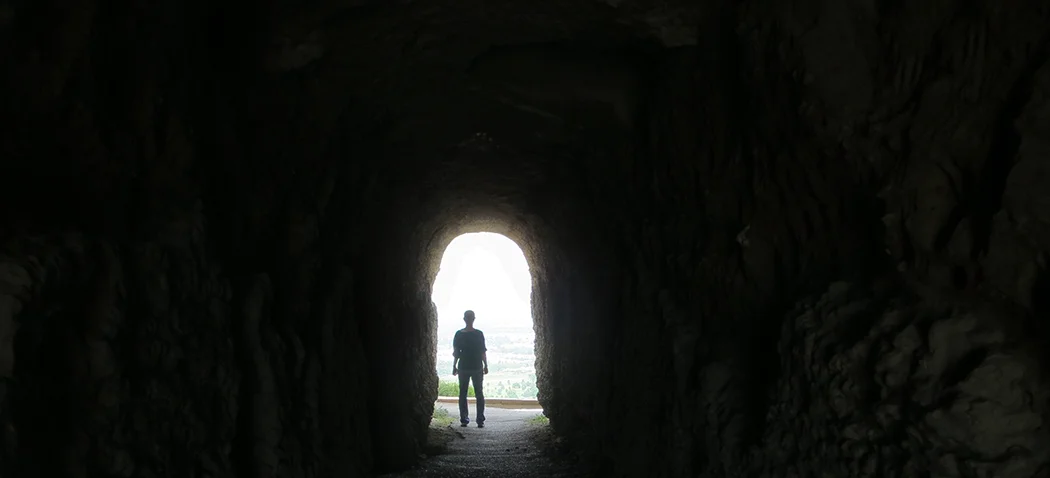Tapestry weaving is in some sense, taking a journey up the warp. It is a process that starts at the bottom and moves upward.
Always.
(okay, almost always)
I know some of you that have watched videos, read books, and even taken courses by some of the weavers prevalent on Instagram may be confused by this. They do teach weaving in the middle of the warp and then filling in around it with a needle. I maintain that this is a poor way to construct a tapestry and I’ll go so far as to even call it wrong. (with apologies for my stubbornness)
Here are my reasons.
1. Construction
Tapestry is a weft-faced fabric. It is almost impossible to create this if you’re trying to weave underneath a shape already woven in the middle of the warp. It is difficult to get the correct amount of weft into your shed which leads to both lice and draw-in and this makes it very difficult to have control over the weaving.
As you weave bottom to top, you can create a firm fabric. You can beat the weft in just the right amount to cover the warp, you can introduce the correct amount of weft to maintain an even weft tension in all areas, and your weaving will stay square (if that is your goal) and won’t bubble when off the loom.
2. Techniques
How are you going to execute a warp interlock if you are attempting to fill two colors in below a shape in your shed? Weaving shapes willy-nilly around your warp severely restricts the techniques you can use for weaving. It leaves you with only plain weave and cuts down on your ability to mix colors, use joins, create more complicated color effects, and it makes the process of weaving really hard!
3. Ease of weaving
If you’re trying to weave under another shape, you’re always going to struggle. When the warp above what you’re weaving is open, you can get a shed. You can open the weaving with a shedding device or a shed stick and have plenty of room to get your bobbin, butterfly, or needle through. If you weave below a shape, you have just destroyed your shed and made the weaving very difficult indeed.
4. Tradition
I know this one isn’t going to be a very convincing argument for many of you. But let me submit that tapestry has been woven for tens of thousands of years starting at the bottom and moving to the top. There are reasons for that. Disagree? I refer you to numbers 1 to 3 above. I’m all for innovation, but I maintain that if you’re using this weave structure, bottom to top is always best.
5. Tapestry is a journey
Tapestry is often referred to as “painting with wool”. This description does irk me a little bit. Tapestry isn’t much like painting at all. When painting, you can put paint wherever you want on a canvas and you can cover over something you don’t like. In tapestry you have to unweave. Also a painter can work on any part of their canvas whenever they want. Tapestry is best built from bottom to top. Tapestry uses yarn to create images. Coloring yarn is a very different process than mixing paint and I can’t just add a little cadmium red light to my purple yarn and change the color in a moment. I have to go back to the dye studio and dye that color before I can weave with it.
I wrote a blog post a few years ago after an article I wrote in Fiber Art Now came out. It was an interview with Susan Martin Maffei and Archie Brennan. In that article I said this:
“One thing I really enjoyed hearing from them was their conception of tapestry weaving as “a journey up the warp.” Partly that comes from the fact that neither of them use cartoons very often. But it also refers to the process of weaving tapestry. We have to start at the beginning and move forward until we come to the end. You can’t go back and change something that is already woven unless you unweave everything on top of it. In their work and in their words, they model a method of tapestry weaving which is full of creativity and exploration.”
I loved hearing Archie describe his practice of tapestry this way. It is marvelous to think of tapestry as a journey. I also find each piece to be a fascinating experiment with “what comes next?” So my final reason for weaving bottom to top is because tapestry is a journey. Start with something and see where it takes you. Be fascinated by each thing that happens and allow the next thing to build from the one before.
Life works that way after all, doesn’t it? One thing leads to the next and the only time we really have is the moment we're currently experiencing.
